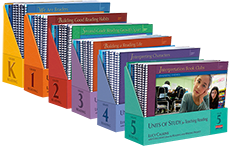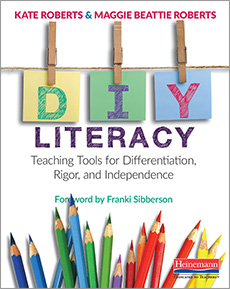There are many ways to keep conference notes digitally! Click here to see my post on using Google!
Conferences in reading are individualized teaching opportunities. They are a time to sit with a student one-one and find out exactly what strategies are being used to decipher and comprehend text. Conferences are similar to coaching. You watch the reader at work and then choose one specific thing that would help them be even stronger readers in the future. The 5-7 minutes that you spend with each student is a valuable time for individualized feedback on a student’s performance.
Conferences can also be good feedback for you on how the class is doing as a whole. What did you notice about the strategies that readers were using? Were they all using the same ones? Did they all struggle in the same areas? Which students needed which specific skills to be better readers? Using the information that you can glean from reading conferences can help you set up the rest of your reading instruction: whole group, small strategy groups, or guided reading.
The trick is to organize the information you have gained so that it is easily transferrable to your instruction. That is where Evernote can help! Evernote is a free app for iPhone or iPad that helps to organize notes of all kinds, but it can be especially useful in conferencing. Below, I will walk through how you can use this app to help you run your reading workshop. You may first want to watch this introductory video that will walk you through the basics.
The first thing you will want to do (after you download the app:) is to set up your notebooks. You will probably want to create one notebook for each student. That will look like this…

Once that is set up, you can begin your conference! I am going to go through a conference in the TCRWP format: Research the reader, Compliment the reader, Choose teaching point/Demonstrate, Active involvement and then the Link.
To demonstrate what this would look like, I conducted a reading conference with my son, Ryan. (He’s such a good sport:)
Researching the Reader:
The first thing that you will want to do is to open up the notebook for the student that you will conference with. Create a new note with the child’s name and the date in the title line.
You can start the conference with “What are you working on as a reader?” This is the time to find out if the child understands what they are reading, how their fluency is going, if they are growing as readers.
Ryan was reading the book, The Dead and the Gone by Susan Beth Pfeffer. In this case, he mentioned that he was having trouble keeping track of characters. There were too many of them! I asked Ryan to read a few paragraphs aloud so that I could make sure that this book was not too difficult for him. In Evernote, you can also record voices by clicking on the microphone at the top.

Complimenting the Reader:
In a conference, it is important to find something to compliment the reader on. This is important because you want your students to realize that they are growing as readers. In this conference, I told Ryan that his fluency was very good. He used great expression and didn’t struggle with any words. That told me he had chosen a just right book for him. I also congratulated him on choosing a book that would offer a little bit of a challenge for him and sticking with it! That was important so he could become a stronger reader.
Teaching Point/ Demonstrating:
I decided to teach Ryan how to keep track of his characters by using a chart and told him so explicitly. I asked him to open up his reading notebook and we drew a chart. I then went back to the beginning of his book and began to read aloud. As I did so, I took notes in his notebook on the characters that I came across.
In Evernote, you can take a picture with your i-Phone/i-Pad to document what you worked on by clicking the Camera at the top of the page.

Active Engagement:
I then asked Ryan to continue reading and show me what notes he would take. I let him read along and watched as he took notes on the next character that was introduced, Uncle Jimmy.
Link:
After being certain Ryan knew how to take notes, I left him saying that these kind of charts can help him in any book he reads when he has trouble keeping track of characters.
Organizing the information in order to plan instruction:
Now it’s time to code the notes from this conference so that you can organize the information. Tagging can help you see what skills you focused on with the class. To tag a note, you click on the i at the top of the page, choose tags and then type the skill that you worked on with the student. By clicking the plus sign, this will save the tag so you won’t have to keep typing it every time a student needs that strategy.

On the Evernote homepage, go to the Tags tab and all of your tags will be organized into strategy groups!

When you click on the strategy tag, the students notes will come up that needed to work on that strategy. There are your strategy groups!!

This information can be organized in many ways… You may want to tag your compliments so that you can see what areas your students are strong in. When you see large groups of students struggling in the same area, you could decide a mini lesson would be most appropriate to teach that skill.
Conferencing is formative assessment in reading. It gives you the opportunity to individually meet each student where they are and make them better, stronger readers. Many teachers have successful systems for managing the information from conferences. Some use a binder with a tab for each student. Some use a post-it note system; some use individual notebooks. Evernote is just one digital option. If you would like to find out more about how Evernote can help you in the classroom, this link will lead you to more resources.
If you know of other tools that could be used to organize conference notes, please share them in the comment box below!
I would like to thank @kerilyn_obrien and @mrsbuckeyebino for the links above and for introducing me to this great resource!
Other Great Resources for Evernote:
Six Ways to Use Evernote to Capture Learning
Using Evernote to Guide Your Guided Reading Groups
Using Evernote for Fluency
Using Evernote with Secondary Students













